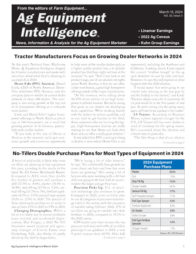Digital connectivity is taken for granted in many areas, but high-speed internet is still absent in many rural areas throughout the country.
According to a 2019 USDA report, if expansion of reliable digital connectivity into rural farming areas were achieved, the benefits could result in a nearly 18% increase in total production, which could equate to more than $50 million in annual gross benefit for U.S. agriculture.
Government initiatives to expand rural broadband appear to be gaining momentum, as the FCC voted in late January to advance a $20 million plan to improve broadband connectivity in underserved rural areas.
The Rural Digital Opportunity Fund (RDOF) plan is an extension of a 2018 program which allocated nearly $1.5 billion to create broadband infrastructure for more than 700,000 rural homes and businesses across 45 states.
The improvements could have short- and longer-term benefits for farmers and precision service providers, says Todd Janzen, attorney with Janzen Ag Law in Indianapolis, especially as automation continues to expand in ag.
“If we’re talking about increased field connectivity, that would be very valuable because we’re hearing and seeing more talk about using artificial intelligence and machine learning on equipment. For that to work, you have to have a good connection to some form of cloud-based process…because your artificial intelligence doesn’t usually just exist on the device. It’s usually connected to some larger mainframe or server where it can combine data and information with other users as well to make decisions.”
Another factor in the expansion of rural broadband is the development of 5G wireless connectivity. The gradual rollout of the network, which began in 2019, by select service providers is designed to provide higher bandwidth and lower latency to a higher volume of digital devices.




Post a comment
Report Abusive Comment